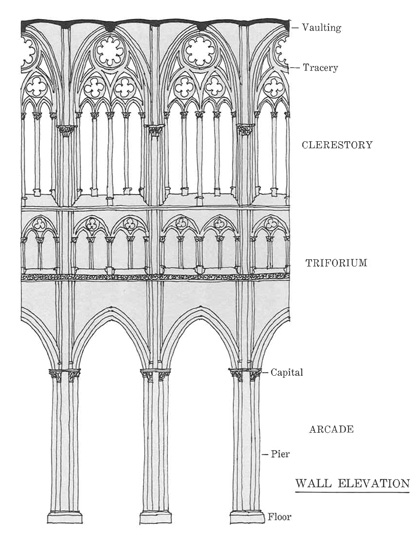Cathedral Floor Plan

PAGE 2
Capital: The form, usually of stone, that supplies the visual transition between the top of a column and whatever the column supports
Crown: The highest part of the arch, where the keystone is located.
Clerestory: The topmost part of the church building whose windows illuminate the central portion of the interior space.
Hurdles: A movable work platform made of woven twigs.
Keystone: The central locking stone at the top of an arch.
Lagging: Temporary wooden planks or frames used to support the courses or layers of webbing stone until the mortar is dry.
Mortice and Tenon: A method of fastening one piece of wood to another. A mortice or square hole is cut into one piece of wood while a tenon or projection the same size as the hole is cut on the end of the other piece. The tenon is then tapped into the mortice, locking the two together without nails.
Mullion: The narrow upright stone pier used to divide the panels of glass in a window.
Pier: The pillar or column that supports an arch.
Tracery: The decorative carved stonework of a medieval church window.
Triforium: The arcaded story between the nave arcade and the clerestory.
Truss: A triangular wooden frame. The roof frame is constructed of a series of trusses fastened together.
Tympanum: The sculptural area enclosed by the arch above the doors of a cathedral.
Vault: The form of construction, usually of brick or stone, that is based on the shape of the arch. Used for the most part as a ceiling or roof.
Voussoirs: Blocks of stone cut in wedge shapes to form an arch.
Windlass: A machine for hoisting or hauling. In the Middle Ages this consisted of a horizontal wooden barrel with a long rope fastened to it. The barrel was supported at both ends. When it was turned the rope would gradually be wound up around it.
Check out an ariel view of a cathedral
More from the complete reading guide to The Pillars of the Earth!
From CATHEDRAL: The Story of Its Construction by David Macaulay. Copyright © 1973 by David Macaulay. Used by permission of Houghton Mifflin Company, www.hmco.com. All rights reserved.



